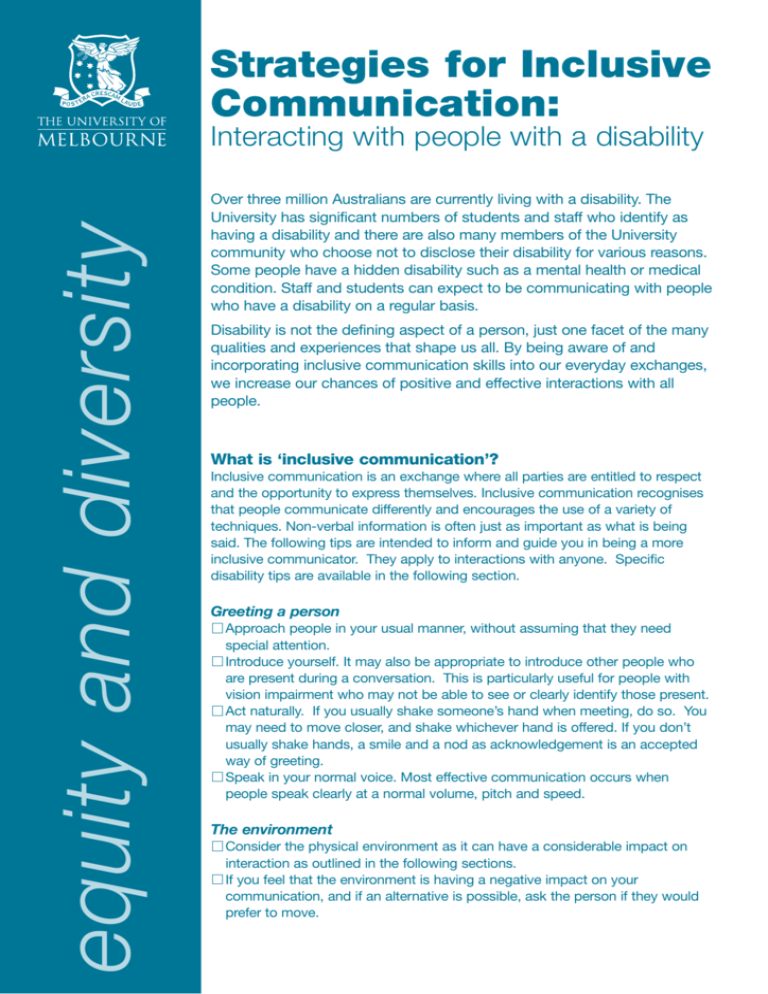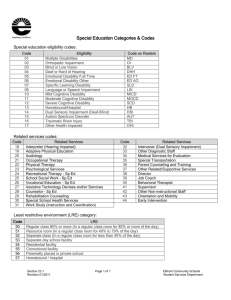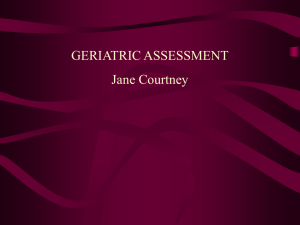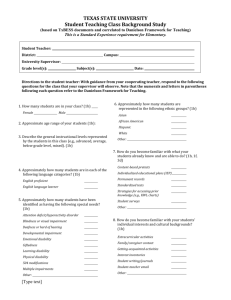Inclusive Communication - University of Melbourne
advertisement

Strategies for Inclusive Communication: equity and diversity Interacting with people with a disability Over three million Australians are currently living with a disability. The University has significant numbers of students and staff who identify as having a disability and there are also many members of the University community who choose not to disclose their disability for various reasons. Some people have a hidden disability such as a mental health or medical condition. Staff and students can expect to be communicating with people who have a disability on a regular basis. Disability is not the defining aspect of a person, just one facet of the many qualities and experiences that shape us all. By being aware of and incorporating inclusive communication skills into our everyday exchanges, we increase our chances of positive and effective interactions with all people. What is ‘inclusive communication’? Inclusive communication is an exchange where all parties are entitled to respect and the opportunity to express themselves. Inclusive communication recognises that people communicate differently and encourages the use of a variety of techniques. Non-verbal information is often just as important as what is being said. The following tips are intended to inform and guide you in being a more inclusive communicator. They apply to interactions with anyone. Specific disability tips are available in the following section. Greeting a person Approach people in your usual manner, without assuming that they need special attention. Introduce yourself. It may also be appropriate to introduce other people who are present during a conversation. This is particularly useful for people with vision impairment who may not be able to see or clearly identify those present. Act naturally. If you usually shake someone’s hand when meeting, do so. You may need to move closer, and shake whichever hand is offered. If you don’t usually shake hands, a smile and a nod as acknowledgement is an accepted way of greeting. Speak in your normal voice. Most effective communication occurs when people speak clearly at a normal volume, pitch and speed. The environment Consider the physical environment as it can have a considerable impact on interaction as outlined in the following sections. If you feel that the environment is having a negative impact on your communication, and if an alternative is possible, ask the person if they would prefer to move. To achieve positive communication outcomes: Allow time. Communication that is rushed is rarely inclusive. The nature of some disabilities means that a person cannot participate equitably in conversations if adequate time is not available. Use normal language – it is fine to say “I have to run” to someone who is a wheelchair user or “See you later” to a person with a vision impairment. These are common expressions that we all use. Speak directly to the person with whom you are communicating and maintain eye contact in a natural manner. Allow time for checking that information has been understood and if necessary clarify. If you don’t understand something that has been said, don’t pretend that you do. Ask again and ensure that you have received the correct message. Consider your choice of words. Regardless of your intent, language can be disempowering and exclude a person with a disability. See examples in the Table. Do not assume that verbal information is the best method of communication. Try using alternatives such as writing notes or using gestures combined with plain language to convey key information. When communicating with a person with a disability, the type of disability and personal communication preferences will influence the most appropriate strategies to use. The following suggestions may prove helpful. • Use your judgement about ‘height’ when conversing with a person using a wheelchair. If there is a seat available so you can be seated at a similar height, you may feel more comfortable seated. • Consider that the wheelchair is an extension of the person’s personal space so do not assume they are comfortable with you touching the chair – always ask. • Do not push a person’s wheelchair or take the arm of someone walking with difficulty without first asking if they would like some assistance. • When assisting a person in a wheelchair up or down a curb, ask if they prefer going forwards or backwards. • When assisting a person in a wheelchair on steps, keep the chair tilted backwards. • Ensure a clear pathway for the wheelchair to the person’s intended destination. • At meetings you may need to make a chairfree space available at the table for the wheelchair. Some people prefer to transfer from their wheelchair to other chairs. • Offer assistance if the person appears to be having difficulty opening a door. • Be prepared. Note the locations of relevant ramps and accessible features, such as toilets or restaurants. • Be aware of your language –wheelchairs enable mobility and terms such as ‘wheelchair bound’ or ‘confined to a wheelchair’ focus on an aid not the person. Tips for interacting with people who have a vision impairment Many people with a vision impairment have some residual vision or light perception. It may be appropriate to ask what they can see, especially in relation to reading materials, overhead screens etc. The following strategies may assist people with a significant level of vision impairment. Tips for interacting with people who have a mobility impairment Not all people with a mobility impairment will use a wheelchair. Sometimes people will have conditions such as back injuries, arthritis or an amputation, all of which can affect mobility. The following strategies are mainly focused towards people who use a wheelchair. • Be specific about directions to places giving approximate distances, and be descriptive when giving directions – give the person the information that is visually obvious to individuals who can see. For example, if you are approaching steps mention how many steps up/down. • On stairs, guide the person’s hand to the handrail. • When assisting with seating gently place the person’s hand on the back of the chair. • If a person would like the assistance of a ‘sighted guide’ walk alongside and slightly ahead of the person. Do not hold their arm but allow your arm to be taken if assistance is required. • When leaving a meeting or discussion, inform the person with the vision impairment that you are leaving the room. If appropriate, ask if they would like you to take them to a familiar landmark so that they can move independently around the campus. • For people with some vision, lighting can be important and subdued or very bright lighting may make things particularly difficult. • Consider the contrast and clarity of printbased materials. Refer to the Improving Information Access for Students with a Print Disability guidelines on the Equity and Diversity Planning website: http://www.services.unimelb.edu.au/ellp/progr ams/equity.html . • Bright glare, such as from windows or concrete surfaces, can make it extremely difficult for people with low vision to see your face. • Inform people who are blind or vision impaired of relevant posted information on notice boards. • Never touch or distract a guide dog without first asking the owner. Tips for interacting with people who are Deaf or hearing impaired People who refer to themselves as ‘Deaf’ come from a culturally Deaf background and Auslan (Australian Sign Language) will usually be their first language. Deaf people are proud of their culture and language and may not perceive their deafness to be a disability. In the educational setting, Deaf students and staff may require sign language interpreters and notetakers or transcription services to enable them to participate equitably. Many people have a hearing loss. This may be present from birth or be acquired later. These people are often referred to as having a ‘hearingimpairment’ or being ‘hard of hearing’. They do not usually use Auslan and are more likely to use hearing aids, assistive listening devices and lip/speech reading. Ask the person how they prefer to communicate. Communication using a sign language interpreter • If a person uses support such as a sign language interpreter, they will be watching both you and the sign language interpreter when communicating. However, you should speak directly to the person rather than to the interpreter. Even when using an interpreter, a person who is Deaf will still be watching you for non-verbal information and will make eye contact with you when there is a break in the conversation. • Remember that the interpreter may lag a few words behind, especially if technical terms need to be finger-spelled, so pause occasionally to allow time for complete translation. Communication using speech/lip reading • Gain the person’s attention before starting a conversation: i.e., come into their line of vision and attract their attention or gently tap the person on the arm or shoulder. • When speaking, face the light, look directly at the person and speak clearly in a normal tone of voice, keeping your hands away from your mouth. This will mean the person can view your facial gestures and possibly lip read when ‘listening’ to you. • Note that wooden floor-boards can transmit vibrations and echo sound which interferes with a communication exchange. • Avoid smoking or chewing gum during conversations. • Avoid turning away from the person while you are talking. • Use short simple sentence structures. • If you are writing a message, don’t talk at the same time. The person cannot read your lips and look at the paper at the same time. This is why students require notetakers in lectures even if they have excellent speech-reading ability. Tips for interacting with people who have a mental health condition ‘Mental health condition’ is a broad term covering a range of specific illnesses. Eating disorders, schizophrenia, depression, bipolar disorder, obsessive compulsive disorder and anxiety disorders are among the health issues covered by the term. • In many instances the person’s mental health condition will have no bearing upon the nature or content of your communication. In most cases it will be impossible to tell whether the person has a mental health condition unless they tell you directly. • As there is often some social stigma still attached to psychiatric disability, in addition to numerous persistent myths, some people find disclosure to others particularly difficult. • If you maintain an approachable manner this may allow a person to feel comfortable about disclosing a mental health condition. • A person’s rights to privacy and confidentiality need to be considered at all times. • Communicating with people in authority can make any person anxious. Be aware that the person with whom you are communicating may find it difficult to express themselves and/or retain important information. Strategies such as slowing the tempo of conversation, seeking clarification and making a note of key points can be useful. • If an accommodation to teaching, assessment or workplace practice has been negotiated, it is sensible for both parties to have a written record of this. • It is appropriate to set boundaries. If a person with whom you are communicating is behaving inappropriately or you are feeling uncomfortable it is advisable to let them know. For example, ‘I know you are upset but it is not okay for you to shout at me’ or suggest you meet at another time when you have both had the opportunity to consider issues further. Any disturbing behaviour evident in the classroom should be discussed with the person privately and future boundaries agreed upon. • It is often hard to manage a situation when you feel a person is unwell but they do not acknowledge this, or if a person discloses information to you and you are unsure how to handle this knowledge. In this situation it can be useful to seek advice from a counsellor about the person, without disclosing their identity. • Whilst people with a mental health condition usually manage their illness well, there are rare instances when someone may exhibit extreme anxiety, depression or potential self-harm. If you feel unsafe, you should call the University’s Security Services on Ext. 46666. For other situations staff members can seek professional assistance from the University’s Counselling Service. DO NOT try to deal with the situation alone. Tips for interacting with people who have speech impairments People can experience difficulty with speech for many reasons. Among these are cerebral palsy, a physical disability of the face or oral cavity, stroke, acquired brain injury and stuttering. Some people will have difficulty with articulation, voice strength and/or fluency; other people may be unable to produce any sounds. Anxiety and stress can often make communication more difficult for someone with speech impairment. Some people continue to use verbal communication as their preferred communication mode whilst others use assistive devices/personnel such as signed communication, communication aides or voice generating hardware and/or software to supplement or replace verbal communication. • Often the most significant barrier to communication for people with a speech impairment is time. Try not to be in a hurry – allow sufficient time for the meeting/discussion. • Be patient, concentrate and take as much time as necessary. • Be mindful that only asking questions that require short answers or a nod/shake of the head may be limiting what the person wishes to communicate. • Do not attempt to finish a person’s sentences. • If you do not understand something the person says, do not pretend that you do. Ask them to repeat what was said and then repeat it back to the person for clarification. • If you are having difficulty understanding what is being said consider writing as an alternative means of communicating, but first ask the person if this is acceptable. Email can be a good way of having a lengthy conversation. Inclusive terminology USE AVOID Condition – Most people with a disability have a specific condition. Affliction – an emotive term to be avoided. Hearing impaired/hard of hearing – describes a person who has difficulty with hearing. Deaf and dumb. Deaf – refers to a person who identifies with the Deaf community. Person with a disability – is respectful as it identifies the person first, rather than their disability, e.g. ‘a person with epilepsy’ or ‘people who have a vision impairment’. Avoid referring to people by the disability they have, i.e. ‘an epileptic’, ‘a diabetic’, ‘a paraplegic’. A person is not a condition. Handicapped, invalid, diseased, disabled person, cripple, physically challenged, retarded, sick, spastic, special, brave, courageous, sufferer, victim – are terms considered outdated, demeaning or patronising. Consider whether a person’s disability needs to be highlighted or mentioned at all, as it may be irrelevant. e.g. ‘Nathan, a student with epilepsy, won the award for an outstanding writing assignment.’ Nathan’s disability is not relevant in this circumstance. Seizure – preferred to the outdated term –fit. Fit. Speech impaired – the most appropriate term to describe someone who has difficulty with speech. Dumb and mute are terms which are now outdated and demeaning. Uses a wheelchair – casts the wheelchair as a tool and portrays the person as being in control. Wheelchair bound/confined to a wheelchair – focuses on the chair – which is just a mobility aid – rather than on the person. Vision impaired/impairment – used in preference Blind to the generic term blind. Person who has a mental health illness/ psychiatric disability. Person who is crazy/mad/insane/psycho. Expressing sympathy about a person’s condition/disability. Additional Resources Disability Liaison Unit (DLU) – Staff at the University’s DLU are available to discuss issues relating to inclusive communication or to provide more detailed information. The DLU website is also a useful resource: www.services.unimelb.edu.au/disability . Phone: 83447068. The University of Melbourne Counselling Service Office Hours: (9am–5pm, Monday to Friday) Phone: 8344 6927, 8344 6928 The University of Melbourne Security Services Security Emergency Number: Ext. 46666. Some useful publications Indirect Discrimination: Fair in Form – Fair in Effect? – brochure produced by the University’s Equity and Diversity Planning Unit in liaison with the Equal Opportunity Unit http://www.hr.unimelb.edu.au/anti-discrimination/indirect-discrimination.pdf Watch your Language: Guidelines for Non-Discriminatory Language – booklet published by the University’s Equal Opportunity Unit. Phone: 03 8344 4438. Equity and Diversity Planning website has a range of publications promoting equity in the University community: http://www.services.unimelb.edu.au/ellp/programs/equity.html Produced by the University of Melbourne Equity and Diversity Planning Unit, in collaboration with the Disability Liaison Unit and the Equal Opportunity Unit and with acknowledgement to: The University of Georgia Disability Resource Centre website at http://www.drc.uga.edu/communicatingwithpeoplewithdisabilities.html and the Scope Victoria website at: http://www.scopevic.org.au/Dis-speak05.pdf Authorised by Dr Patricia McLean Director Equity, Language and Learning Programs. December 2005





